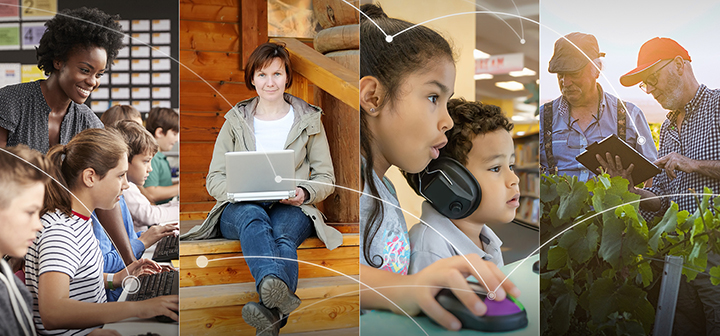Not open? No problem. Rural Libraries Push WiFi Into Community Spaces

By Scott G. Allen, Deputy Director, Public Library Association
In the three northeastern Texas counties of Wood, Hopkins, and Franklin, the combined population density is about 127 people per square mile and the notion of getting and staying technologically “connected” can be something of a pipe dream.
As in many rural areas, access to both WiFi and cellular is severely limited. It makes the Gilbreath Memorial Library a critical resource, not just for the books and periodicals that allow people to explore the world from the comfort of home, but for the technology that really does help them stay connected so they can pay bills, read emails, and do work, for school or for employers.
When the COVID-19 pandemic hit, those who live in such remote areas may have been among the hardest hit. Getting access to WiFi safely – outdoors and away from crowds – can relieve the isolation. It’s something the Gilbreath library (along with more than 60 other libraries in rural regions) can now more easily facilitate, thanks to a $120,000 grant program offered by the Public Library Association (PLA) and Microsoft.
The program was designed to extend public WiFi access points on or near recipient library grounds. The need was underscored in a PLA survey during the economic shutdown in March 2020 as the pandemic was worsening: 80% of respondents said they left their public WiFi access on when their buildings were closed, and 12% have added or expanded this service – many adding access points outside the building.
This initiative to help public libraries extend their WiFi access specifically targets rural libraries because they serve communities where the digital divide is most pronounced. The dearth of people can mean less of an investment by providers in the enabling technology, but these also are poorer regions where the cost to access high-speed internet can be beyond the means of many.
Early in 2020, the U.S. Federal Communications Commission approved a $20.4 billion Rural Digital Opportunity fund to narrow the gap, using census data to determine and prioritize regions that are least connected. An issue that could hinder the equitable distribution of federal dollars, however, is that independent researchers have found the FCC may have underestimated how many Americans lack access by some 20 million people, doubling the FCC’s 21.3 million estimate. If its count is off, funding might be, too.
Especially during the pandemic, public libraries that have been able to extend public WiFi networks through the PLA/Microsoft program are performing a much needed service.
The Westford (VT) Public Library is one that was able to advance closer to its goals of equitable, open access, and a support network for area businesses and tourism. Through the collaboration of the Westford Public Library, Red Brick Meeting House, and the Westford Economic Development Committee, two grants were creatively combined to create a public Wifi network covering the entirety of the Westford Common. With coverage now provided throughout the community’s main park and recreation area, it has been put to various uses, from supporting outdoor summer learning initially, to enabling the local food truck to accept and process credit cards.
“Our town library has been a bright spot during the pandemic. Their network is the only public internet for 10+ miles in all directions–there are always people parked in cars outside,” says Mark Drapa of the Westford Economic Development Committee.
Extended WiFi access through the Cuba (NY) Circulating Library has benefitted a variety of patrons with various needs. A senior citizen is now more easily able to communicate with family members. Unemployed community members find the prospect of applying for unemployment benefits as well as jobs less onerous with the WiFi connection.
Says Library Director Tina Dalton, “We’ve also had students coming into to do their Zoom classes at the library, utilizing the WiFi here because they don’t have access at home. We have one gentleman who is ‘working from home’ during the shutdown but doesn’t have internet at home. He regularly uses the WiFi at the library, and checks out a hotspot to take home.”
And for the community served by the Gilbreath Memorial Library? As many as 300 people use its external WiFi signal each week. A nursing student uses it frequently, having no access at home. Another resident was able to complete the process of getting custody of his daughter, thanks to the ability to get online to access and complete necessary forms.
Public libraries are integral to community life, and that may be particularly so in rural areas. Small and rural libraries, which constitute one-third of all in the U.S., may be more challenged than most to meet their communities’ needs, due to limited staff, space, and resources. It is partnerships like those that PLA and Microsoft have forged that can make a real difference. Get more information about this project, DigitalLead: Rural Libraries Creating New Possibilities here. Go here for more information about the Public Library Association, or follow PLA on Facebook.
Scott G. Allen is Deputy Director of the Public Library Association, a division of the American Library Association. He can be reached at sallen@ala.org.
Tags: covid-19 pandemic remote areas, DigitalLead: Rural Libraries Creating New Possibilities, PLA DigitalLead, Public library wifi, rural access to wifi












